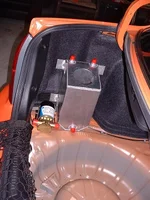mazda2002 said:
I don't really get the pgysics in back of the peltier elements, I will keep on reading about it.
How much do these things cost? Because the ones that they show on the site seem verry small and will the car battery give enough power to run enough peltier elements to cool down quickly.
Do you plan on sticking the cold side on the tank of water or to have fins in the water and to place it directly in the water.
How do you plan on dissapating the heat? If you could make a cooling system with a small oil cooler and a way to have the hot side connected to it, it might work alot better? Have you thought of that?
How fast does it heat up or start cooling down, could this be used only when it is neede or does it have to worm up?
This is not the right forum for deep physics, but Peltiers work on the principles of thermocouples. For a light discussion of Peltier elements, see this site:
Peltier Elements
How fast do Peltiers reach operating temps? It varies based upon how much current (12 volts DC) is available. At idle only about 40% of your alternater's current is being produced. The amount is even lower when ambient temperature gets above 90*F.
If unlimited current is available (or at least the maximum current rated for the device), it can reach operating temperature in under 30 seconds. If the coolant fluid is already hot (you've been driving around and stop at the Kwik-e-Mart), it will take longer for the Peltier to reach it's lower temps because of the heat that it is extracting out of the water. Remember, Cold does not really exist, it is only the absence of heat.
The idea for dissapating the heat is to attach the peltiers (cold side) directly to the side of the aluminum tank. Each Peltier will also have to have a heat sink attached to it's hot side to dissipate the heat transferred from the water. It might also be purdent to put small muffin fans on the heatsinks (think: computer CPU heatsink & fan).
Something else you can do to control the current draw is install a dial (potentiometer) to control how much current the peltiers draw. I've seen this done on computer cases where the user could dial up more current when they wanted to really overclock the CPU, or less when running at regular speed. This could allow you to dial down the current draw when chugging around town and crank it up when racing down the strip.
By attaching the peltiers directly to the aluminum tank, the whole tank really becomes a cold plate. You could make the argument that the luquid sitting in the center of the tank is receiving the least amount of cooling, but in reality, heat spreads through water/antifreeze pretty evenly, so the cooling effect would be even as well.
Cost? It varies by size of device, amount of heat the device can move (wattage), duty cycle of the device (lifespan), etc...
Here's a page on some prices on a few of these devices, to give you an idea:
Peltier Prices
Enjoy

